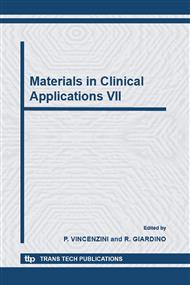[1]
F. Orgaz, J. Rincón, F. Capel. Bol. Soc. Esp Ceram. y vidrio 26. (1987), 13-19.
Google Scholar
[2]
J.A. Oribe JA, Rajcovich G. Cirugía Maxilofacial. (López Libreros 1981).
Google Scholar
[3]
D.F. Williams. Mater Sci and Tech 3 (1987), 797-806.
Google Scholar
[4]
D.F. Williams. Interdisciplinary Science Reviews, 15 (1990). 20-33.
Google Scholar
[5]
D.F. Williams. J Master Sci 22 (1987), 3421-3443.
Google Scholar
[6]
R.L. Price, K.M. Haberstroh and T.J. Webster. Medical and Biological Engineering and Computing 41 (2003), 372-375.
Google Scholar
[7]
D. Laufer, D. Beri-Shechar, E. Livne, G. Maor and M. Silberman. J Cranio Maxillo-fac Surg 16 (1988), 40-45.
Google Scholar
[8]
H.G. Jacobs, H. Luhr, G. Krause. and H Uberall . Deutsche Zeistch. Mund-Kiefer-Gesicht chirurgie, 8 (1984), 38-42.
Google Scholar
[9]
L.L. Cossi Cerbasi and P. Moratinos Palomero. Rev. Esp. Cirug. Oral y Maxilofac. 17 (1995), 231-236.
Google Scholar
[10]
R. Holmes and H. Hagler. J CranioMax Fac Surg, 16 (1988), 199-205.
Google Scholar
[11]
Piermattei & Greckey. An Atlas of surgical approaches to the bones of the dog and cat. 2nd ed. (W.B. Saunders co, New York, USA, 1979).
Google Scholar
[12]
J. Grandage: in Texto de Cirugía de pequeños animales. D.H. Slatter ed Tomo Ι (Barcelona: Salvat Ed.S. A, Barcelona, España, 1989).
Google Scholar
[13]
E. Pifarré Sanahuja. Patologia Quirúrgica Oral y Maxilofacial. (ed. Juins S.A. España, 1994), pp.566-567.
Google Scholar
[14]
C. Mascres and J.F. Marchand. Oral Surg Oral Med Oral Pathol 50 (1980), 164-175.
Google Scholar
[15]
R. Massas,S. Pitam and M.M. Weinreb. J Dent Res 72 (1993), 1005-1008.
Google Scholar
[16]
C.A. Lorente, B.Z. Song and R.B. Donoff J. Oral Maxillo-fac. Surg. 50 (1992), 1305-1309.
Google Scholar
[17]
R. Skalak . J Prosthet Dent 49 (1983), 843-848.
Google Scholar
[18]
F. Beltrame,R. Cancedda ,B. Canesi, A. Crovace, M. Matrogiacomo, R. Quarto, S. Sacaglione, C. Valastro, and F. Viti. Biotechnol Boieng. 20 (2005), 189-98.
DOI: 10.1002/bit.20591
Google Scholar
[19]
Y. Akagawa, Y. Ichikawa, H. Nikai, H. Tsuru. J Prosthet Dent. 69 (1993), 599-604.
Google Scholar
[20]
K. Hayashi, N. Matsuguchi, K. Uenoyama and Y. Sugioka. Biomaterials 13 (1992), 195-200.
Google Scholar
[21]
K. Hayashi, N. Matsuguchi, K. Uenoyama and Y. Sugioka. Biomaterials, 14 (1993) 1173-1179.
Google Scholar
[22]
L. Hao, J. Lawrence and K.S. Chian. J Mater Sci Mater Med. 16 (2005), 719-726.
Google Scholar
[23]
L. Sennerby, A. Dasmah, B. Larson and M. Iverhed. Clin Implant Dent Relat Res. 7 (2005), Duppl 1: S13-20.
Google Scholar


